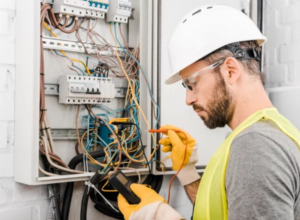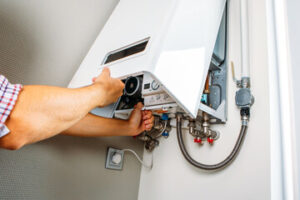Electricity is the flow of charged particles and is a form of energy. It’s related to magnetism, and both are part of the electromagnetic force. For more information, click the link https://www.epicelectrical.com/ provided to proceed.
A complete path around which electricity can flow is called a circuit. Materials that allow electric current to pass through easily are called conductors.

Electrons are negatively charged particles that circle the positively charged nucleus of an atom. They balance positive and negative charges, allowing the atom to attract or repel other atoms, forming chemical bonds.
The electron is one of three basic subatomic particles — protons and neutrons — that make up atoms, the building blocks of all matter and chemistry. The protons and neutrons comprise the atomic nucleus, and the electrons orbit it. Because of the electrons’ negative charge, they attract each other like opposite ends of a magnet. This attraction, the source of the atom’s magnetic properties, gives a substance its electrical properties.
Like other subatomic particles, the electron can behave as both a wave and a particle. When behaving like a wave, it can take on many different shapes. The shapes it takes are determined by the electron’s energy type and by the shape of the potential well that traps it. When bound in a simple hydrogen atom, for example, the electron can have the shapes of layered spheres (the “s” states), layered dumbbells (the “p” states), and layered four-leaf clovers (the “d” states). At higher energies, an electron can take on even more complex shapes.
When an electron behaves more like a particle, it can only have a limited number of shapes. In these cases, physicists say that the electron has no shape. This is because when a particle interacts with other particles in a particular way, it’s considered located at one point in space rather than spreading out to fill a volume of space.
An electron can also pair with its antiparticle, which carries the same positive electric charge but is the opposite of it. When an electron collides with its antiparticle, the particles annihilate each other. This process is what produces gamma rays when certain nuclear reactions take place. This is another reason the electron and positron are often used as symbols for photons, which are their equal and opposite counterparts.
A current is a flow of electric charge. This can be negatively charged electrons or positively charged protons, positive ions, or holes. It is measured in units called coulombs per second, with the most common unit being the ampere or amp, represented by the letter A. A single ampere means that 1 coulomb of charge passes through a cross-section of the wire every second. This measurement is like describing water flow as how many gallons pass by a point in a pipe each minute (or hour).
If there is no force on the electrons to move in a specific direction, they will drift around their molecules fairly haphazardly. However, if a current is applied, the electrons will start to move in one direction. The current flow direction causes an electro-motive force to act on the electrons.
This force pulls the electrons together from their positions in different parts of the circuit and pushes them through the wire. When the electrons are pulled through the wire, they bump into other particles in the wire, atoms, for example. These collisions impede the electrons from continuing to flow along their desired path. Eventually, the electrons will reach the end of the wire and stop flowing. This is because the wire has resistance determined by the material, diameter, and length.
Some materials allow the free movement of electrons; therefore, they are conductors. Others do not and are insulators. When an insulator is part of a circuit, the electrons cannot travel from one end of the circuit to the other. However, when a switch is closed, and the circuit completes, current can flow from one end to another. In the case of a lamp, this current will allow it to light up. However, if the switch is opened and the lamp is no longer connected to the wires, it will stop flowing. This is because the energy initially used to power the lamp has been transferred back to the source of electricity (the battery).
Voltage is the electrical pressure that drives current. High voltage means more pressure, while low voltage means less pressure. Both voltage and current can be dangerous if handled incorrectly, so it’s important to understand them and to take the proper precautions when working with electricity.
Electric current is the flow of electrons through a circuit, measured in amperes (amps). An ampere measures how many electrons pass a particular point in a circuit in one second. The speed of electron movement depends on the circuit’s voltage and the circuit’s resistance. For example, if a wire has a higher voltage and lower resistance, more electrons can move through it simultaneously.
The potential energy of electrons inside a conductive metal is affected by both their average electric charge and the thermal and atomic environment that they’re in. For this reason, the potential energy of an electron is different when it’s in one type of metal than another. Unlike electrostatic energy, which can be measured with a voltmeter, this difference is not measurable and is often referred to as Galvani or unadjusted electrostatic potential.
When electricity is generated in a power plant, it’s raised to high voltage to transmit it over long distances with minimal energy loss. At the destination, it’s stepped down to medium or low voltage by transformers. The ability to vary voltage is what makes modern electrical systems so efficient.
The higher the voltage, the more electrons can flow through a circuit and work, such as lighting a bulb. However, too much voltage can damage electronic devices and prevent them from operating properly. Voltage is also dangerous if exposed to the skin, so people should always wear rubber gloves when handling electricity. Despite its dangers, high voltage is preferred for transporting large amounts of electricity over long distances because it’s cheaper than generating and transmitting low voltage. Low voltage, on the other hand, is usually used to power small devices.
Electric circuits are pathways that allow electricity to flow and provide the power needed for devices like light bulbs to work. They comprise components that can conduct electricity, including wires and other materials that allow electrons to pass through easily, such as copper or aluminum. Conductors are connected to a power source, usually batteries, to make up the complete electric circuit. Electric current wants to flow from a higher voltage to a lower one, and when it does so, it gives off a small amount of energy that can be used by the device in the circuit (such as a light bulb).
The battery or other power source controls the electrical current to ensure it doesn’t damage the circuit. This is why it is important that we only connect the positive and negative ends of a battery when we are ready to use it. Otherwise, the electrons will start moving away from the negative terminal and towards the positive, which can damage the battery.
We use a series of symbols to represent the different parts of a circuit in a schematic diagram. These are simplified, standardized representations of the real thing; there is no room for the complexity of the actual connection points in the real world.
A symbol represents each part of the electric circuit; a single line represents an electric wire, while a circle means the element is closed. We also use lines to show how the individual components of the circuit are connected. A loop is a continuous path in the circuit. We can also use triangles and squares to represent components of the circuit.
A circuit with no loops or breaks is called a closed circuit; the opposite is an open circuit. When there is a break in the circuit, the electrons cannot flow from one end of the circuit to the other, and the device in the circuit will not receive any power. A more complicated circuit comprises many elements, such as resistors, capacitors, and inductors. An equivalent circuit is a simplified representation of a complex circuit, maintaining similar electrical characteristics.

